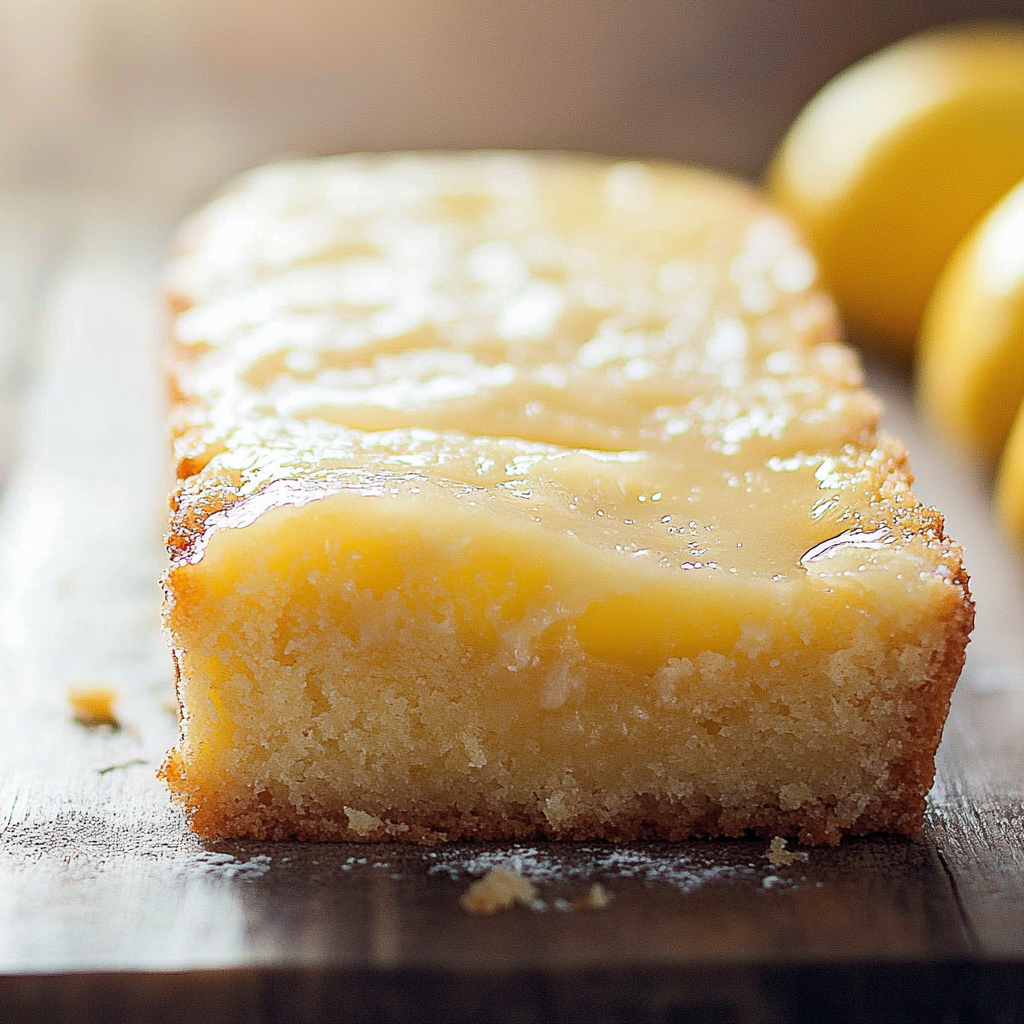If you’re searching for a light and refreshing treat to brighten your day, look no further than this delightful lemon loaf. This easy recipe captures the essence of vibrant lemons and transforms it into a moist, tender bread that pairs perfectly with tea or coffee. With its zesty flavor and lovely aroma, this lemon loaf is not just a dessert; it’s an experience that can elevate any gathering or even serve as a comforting snack at home.

Baking a lemon loaf is a straightforward process that requires minimal ingredients yet delivers maximum flavor. The beauty of this recipe lies in its simplicity. You don’t need to be an expert baker to achieve bakery-worthy results. Each slice reveals a golden crust and an inviting crumb that melts in your mouth. Whether you enjoy it plain or topped with a drizzle of icing or fresh fruit, this lemon loaf is sure to become a favorite at your table.
In this article, we will walk you through the essential ingredients needed for the perfect lemon loaf and provide detailed step-by-step instructions for preparation. Along the way, you will also learn some helpful serving and storing tips to ensure your creation remains delicious for days on end. Get ready to impress your friends and family with this irresistible homemade treat!
Main Ingredients
Fresh Lemons
Fresh lemons are the star ingredient in our lemon loaf recipe. They provide the essential tangy flavor that defines this dish. For the best results, choose organic lemons when possible; they have more vibrant flavors and are free from harmful pesticides. You’ll need about three medium-sized lemons to yield enough zest and juice for one loaf.
All-Purpose Flour
All-purpose flour serves as the base for our lemon loaf. It provides structure without being too dense, allowing the loaf to rise beautifully while remaining moist. For this recipe, we will need two cups of all-purpose flour sifted before measuring to ensure that our cake has the right texture.
Granulated Sugar
Granulated sugar adds sweetness and balances the tartness of the lemons perfectly. It contributes to the moistness of the loaf as well by helping to retain moisture during baking. We will use one cup of granulated sugar, which will enhance both flavor and texture in every bite.
Unsalted Butter
Unsalted butter is essential for creating a rich flavor profile while keeping our lemon loaf moist. Using unsalted butter allows us to control the salt levels better since we can add salt separately according to taste preferences. You’ll need half a cup (one stick) of softened unsalted butter for this recipe.
Eggs
Eggs play a crucial role in providing moisture as well as contributing to the overall structure of our lemon loaf. They help bind all ingredients together while adding richness. For our recipe, we’ll need two large eggs at room temperature for optimal mixing.
Baking Powder
Baking powder acts as a leavening agent that helps our lemon loaf rise beautifully while ensuring a light texture throughout each slice. It’s important not to confuse baking powder with baking soda; they serve different purposes in baking chemistry! We will use one teaspoon of baking powder in our mix.
Salt
Salt enhances all flavors in baked goods by balancing sweetness; it’s an essential ingredient even in sweets like our lemon loaf! A pinch (about half a teaspoon) will bring out the best flavors without making your cake taste salty.
Milk
Milk adds moisture while enriching taste without overwhelming other flavors present in the recipe—perfectly complementing those zesty notes from lemons! We’ll require half a cup of whole milk or any milk alternative you prefer.

How to Prepare Lemon Loaf
Step 1: Preheat Your Oven
Before diving into mixing your ingredients, preheat your oven to 350°F (175°C). This important step ensures that your lemon loaf bakes evenly from start to finish without any unwanted surprises like sinking centers or uneven textures later on! While waiting for your oven temperature to rise, prepare your baking pan—grease it lightly with butter or line it with parchment paper for easy removal after baking.
Step 2: Mix Dry Ingredients
In a separate bowl, combine all-purpose flour, baking powder, and salt thoroughly using either a whisk or spoon until evenly blended—this prevents clumps when integrated into wet mixtures later on! Sifting these dry ingredients together can also create lighter textures across baked goods by aerating them before mixing them into batter!
Step 3: Cream Butter And Sugar
In another large mixing bowl (preferably using an electric mixer), cream softened unsalted butter along with granulated sugar until light-colored fluffy consistency develops—usually around two minutes should suffice! Avoid over-mixing because doing so may lead cakes losing their desired softness once baked! Make sure everything combines nicely before moving onto adding eggs next!
Step 4: Incorporate Eggs And Lemon
Once butter-sugar mixture is fluffy enough (remember not over-beat!), add room-temperature eggs one at time—mixing well after each addition until fully combined! Then zest three medium-sized fresh lemons using fine grater followed by juicing them into separate measuring cup—ensure no seeds remain! Finally blend these fragrant zest & juice mixtures into batter ensuring they distribute evenly across mixture giving delightful citrus aroma throughout!
Step 5: Combine Wet And Dry Mixtures
Now slowly introduce previously mixed dry ingredients into wet batter—alternating between dry mixture & whole milk—with spatula gently folding them together until just combined without visible flour streaks remaining visible! Be careful not over-mix here since incorporating too much air may lead tougher loaves post-baking instead desired soft texture!
Step 6: Pour Batter Into Pan
Once everything looks well-combined but still slightly lumpy—that’s perfectly fine! Pour prepared batter into greased pan spreading evenly across surface utilizing spatula smoothing top gently if required ensuring even bake throughout process ahead! Place pan inside preheated oven allowing magic begin happening slowly transforming raw elements into glorious baked good!
Step 7: Bake
Bake your delicious creation inside preheated oven set at 350°F (175°C) around 45 minutes check doneness by inserting toothpick center if comes out clean then it’s ready otherwise continue baking monitoring every few minutes until done achieving golden-brown edges while center springs back lightly when pressed down gently!
Step 8: Cool Down Before Slicing
After removing from oven allow cooling inside pan ten minutes then carefully transfer onto wire rack cool completely before slicing into pieces sharing joyfully others around you enjoying every last crumb celebrating success together enjoying creation made lovingly homemade way!

Serving and Storing Tips
Serving Suggestions
Your freshly baked lemon loaf can stand alone as an impressive dessert but pairing it up elevates experience further! Slice thinly serve alongside dollops homemade whipped cream drizzled honey infusing sweetness harmoniously enhancing tartness inherent within cake itself bringing delightful balance palates crave during gatherings parties alike feel free sprinkle powdered sugar garnishing top visually appealing aspect serving plate too!
Another delectable option involves preparing glaze using powdered sugar & additional fresh squeezed juice whisked together till smooth drizzling generously over cooled slices creating extra layer sweetness enticing guests wanting more even adding colorful berries fruits topping elevating presentation bringing vibrant colors appealing eyes tantalizing taste buds simultaneously delighting senses altogether!
Storing Tips
To keep your tasty treats fresh longer consider wrapping individual slices tightly plastic wrap placing inside airtight container refrigerator extending shelf life up five days maintaining optimal freshness preserving lovely textures flavors intact enjoy anytime cravings arise during week ahead effortlessly grab ready-to-eat snack indulgently satisfying hunger pangs when needed most!
If planning indulge later rather than sooner freeze entire cooled unglazed loaves securely wrap cling film aluminum foil preventing freezer burn protecting lusciousness awaiting future enjoyment thaw overnight refrigerator prior serving same delightful tastes loved everyone first indulging moments shared earlier multiple times over again possible without compromising quality whatsoever enhancing experiences shared among family friends alike relishing sweet memories created through wonderful recipes shared lovingly made kitchen spaces felt warmth laughter echoing joy filled hearts forever cherished moments spent together celebrating life’s simple pleasures found within food shared amongst loved ones continuously nourishing bonds cherished forevermore!
Mistakes to avoid:
Overmixing the batter
When making lemon loaf, one common mistake is overmixing the batter. Overmixing can lead to a dense and tough texture instead of the light and airy loaf you desire. When you combine the wet and dry ingredients, mix just until you see no more flour. The batter should be slightly lumpy. This method ensures that the gluten doesn’t develop too much, which keeps your lemon loaf tender. If you find clumps of flour remaining, don’t worry; they will typically dissolve during baking.
Not using room temperature ingredients
Another frequent mistake is not using room temperature ingredients. Cold butter or eggs can cause your batter to curdle or not emulsify properly. For best results, leave your eggs out on the counter for about an hour before baking and soften your butter by letting it sit at room temperature for a similar duration. Room temperature ingredients blend more easily and contribute to a smoother batter, enhancing the overall texture of your lemon loaf.
Ignoring ingredient quality
Quality matters when it comes to baking a delicious lemon loaf. Using subpar ingredients can significantly affect the taste and texture of your final product. Opt for fresh lemons instead of bottled lemon juice, as fresh juice offers a brighter flavor profile. Additionally, choose high-quality flour and sugar for better results. Always check expiration dates on baking powder or soda as well; expired leavening agents can lead to a flat loaf that fails to rise properly.
Underbaking or over-baking
Finding the right balance in baking time is crucial for achieving a perfect lemon loaf. Underbaking might leave you with a gooey center while overbaking can result in dryness. To avoid this mistake, check for doneness by inserting a toothpick into the center of the loaf; it should come out clean or with just a few moist crumbs attached. Remember that ovens vary, so keep an eye on your loaf during the last few minutes of baking.
Tips and tricks:
Use fresh lemons
When preparing your lemon loaf, always opt for fresh lemons instead of pre-packaged lemon juice. Freshly squeezed juice gives your cake an authentic flavor that bottled versions cannot replicate. Zesting fresh lemons also adds aromatic oils that enhance the overall taste of your bread. Make sure to wash your lemons thoroughly before zesting to remove any wax or pesticides.
Let it cool completely
Once you take your lemon loaf out of the oven, resist the urge to slice into it immediately. Allowing it to cool completely ensures that it sets properly and makes slicing easier without crumbling apart. Cooling on a wire rack helps air circulate around the bread, preventing sogginess from steam buildup at the bottom.
Experiment with add-ins
While traditional lemon loaf recipes focus on lemon flavor, consider adding other complementary flavors and textures too! Ingredients like poppy seeds add crunch while enhancing visual appeal with their tiny black dots against yellow bread. You could also try incorporating blueberries or cranberries for added sweetness and tartness that pairs beautifully with lemon.
Store properly
Storing your lemon loaf correctly will maintain its freshness longer. Once cooled, wrap it tightly in plastic wrap or aluminum foil before placing it in an airtight container at room temperature for up to three days. If you want to extend its shelf life further, consider freezing slices individually wrapped in plastic wrap and placed in a freezer-safe bag.
Suggestions for lemon loaf:
Pair with tea or coffee
One delightful suggestion when serving your lemon loaf is pairing it with tea or coffee! A cup of Earl Grey tea complements citrus flavors beautifully while offering an aromatic experience alongside every slice of cake you enjoy together. Alternatively, coffee lovers may find that rich espresso balances out the sweetness perfectly—creating an indulgent afternoon treat!
Glaze it up
For an extra layer of flavor, consider glazing your lemon loaf! A simple glaze made from powdered sugar mixed with freshly squeezed lemon juice will elevate its presentation while intensifying citrus notes in every bite! Drizzle this sweet topping over cooled bread before slicing—it’s sure to impress guests at gatherings or brighten up any day at home!
Add frosting if desired
If you’re looking for something more decadent than just glaze, cream cheese frosting could be another excellent addition! A tangy yet sweet cream cheese topping pairs wonderfully with tartness from lemons—creating an irresistible combination that’s hard to resist! Spread generously across each slice after cooling down completely—this will turn ordinary moments into special occasions!
Make mini loaves
Consider making mini versions of your beloved lemon loaf! Baking smaller loaves allows for easy sharing while adding variety if hosting gatherings or brunches! Adjust baking time accordingly—typically reducing by about 10-15 minutes—and enjoy these adorable treats baked just right! Mini loaves also make thoughtful gifts packaged beautifully for friends and family!
FAQs:
What ingredients do I need for a lemon loaf?
To make a delicious lemon loaf, you will need the following ingredients: all-purpose flour, granulated sugar, baking powder, salt, eggs, fresh lemon juice, lemon zest, vegetable oil, and vanilla extract. These basic ingredients come together to create a moist and flavorful cake. The fresh lemon juice and zest are crucial as they infuse the loaf with that signature tangy flavor. You can also consider adding optional ingredients like poppy seeds or blueberries for added texture and taste. Make sure your ingredients are at room temperature for the best results. This ensures even mixing and helps achieve a fluffy texture in your lemon loaf.
How long does it take to bake a lemon loaf?
Baking a lemon loaf typically takes about 50 to 60 minutes at 350°F (175°C). However, baking times can vary based on your oven’s accuracy and the size of your loaf pan. It’s essential to check for doneness by inserting a toothpick into the center of the loaf. If it comes out clean or with just a few crumbs attached, your lemon loaf is ready! Let it cool in the pan for about 10 minutes before transferring it to a wire rack. This cooling period helps prevent the loaf from breaking apart when removed from the pan.
Can I freeze my lemon loaf?
Yes, you can absolutely freeze your lemon loaf! Freezing is an excellent option if you want to enjoy this delightful treat later. To freeze, first allow the loaf to cool completely. Wrap it tightly in plastic wrap or aluminum foil to prevent freezer burn. Then place it in an airtight container or freezer bag. Your lemon loaf can be stored in the freezer for up to three months. When you’re ready to enjoy it again, simply thaw it at room temperature for a few hours or overnight in the refrigerator before serving.
What’s the best way to store leftover lemon loaf?
To keep your leftover lemon loaf fresh, store it in an airtight container at room temperature for up to three days. If you want it to last longer, refrigerate it; however, this may slightly alter its texture. For optimal freshness while refrigerated, wrap the loaf tightly in plastic wrap or foil before placing it in a container. If you see any signs of mold or if it develops an off smell, it’s best to discard it. Remember that moisture is key; keeping your lemon loaf well-wrapped prevents drying out while still allowing some air circulation.
Can I make gluten-free lemon loaf?
Absolutely! You can easily make gluten-free lemon loaf by substituting all-purpose flour with a gluten-free flour blend. Many blends work well without affecting flavor or texture significantly; just ensure that they include xanthan gum if needed for structure. Additionally, check other ingredients like baking powder and vanilla extract to confirm they are gluten-free as well. Follow the same recipe proportions and baking time as you would with regular flour; just keep an eye on doneness since gluten-free baked goods may require slight adjustments.
How can I enhance the flavor of my lemon loaf?
There are several ways to enhance the flavor of your lemon loaf! Adding poppy seeds gives a lovely texture and visual appeal while complementing that zesty citrus taste beautifully. You might also consider incorporating additional citrus elements such as orange zest or juice for complexity. Drizzling a simple glaze made from powdered sugar and fresh lemon juice over the top adds sweetness and makes it visually appealing as well. For those who love herbs, try adding finely chopped rosemary or thyme; they pair surprisingly well with citrus flavors!
Print
Lemon Loaf
- Total Time: 1 hour
- Yield: Serves 8
Description
Indulge in this easy-to-make lemon loaf that captures the refreshing essence of citrus in every bite. With its moist texture and zesty flavor, this delightful treat is perfect for afternoon tea, dessert, or simply as a comforting snack. Each slice boasts a golden crust and an inviting crumb that melts in your mouth. Whether enjoyed plain or with a sweet glaze, this lemon loaf is sure to impress family and friends at any gathering.
Ingredients
– 3 medium-sized fresh lemons (zest and juice)
– 2 cups all-purpose flour
– 1 cup granulated sugar
– ½ cup unsalted butter (softened)
– 2 large eggs (room temperature)
– 1 teaspoon baking powder
– ½ teaspoon salt
– ½ cup whole milk
Instructions
1. Preheat oven to 350°F (175°C) and grease a loaf pan.
2. In one bowl, whisk together flour, baking powder, and salt.
3. In another bowl, cream butter and sugar until fluffy; add eggs one at a time.
4. Mix in lemon zest and juice, then alternate adding dry ingredients with milk until just combined.
5. Pour batter into the prepared pan and bake for about 45 minutes or until a toothpick comes out clean.
6. Allow cooling before slicing.
Notes
– For added texture, consider mixing in poppy seeds or blueberries.
– Drizzle with a simple glaze made from powdered sugar and lemon juice for extra sweetness.
- Prep Time: 15 minutes
- Cook Time: 45 minutes
Nutrition
- Calories: 210
- Fat: 10g
- Carbohydrates: 30g
- Protein: 3g
In summary, making a scrumptious lemon loaf is both enjoyable and rewarding. By using simple ingredients such as flour, sugar, eggs, fresh lemons, and vanilla extract, you can create a delightful dessert that pleases everyone’s palate. Remember that proper storage techniques extend its freshness; wrapping leftovers carefully makes all the difference when preserving taste and texture.
Baking time may fluctuate based on various factors such as oven variability but checking with a toothpick ensures perfectly baked results every time. Should you wish to customize your recipe further with add-ins like poppy seeds or blueberries? Feel free to experiment! Most importantly, don’t hesitate to freeze extra loaves for later enjoyment without sacrificing quality.
Ultimately, whether enjoyed fresh from the oven or saved for later savoring moments—this classic lemon loaf recipe is sure to become one of your cherished favorites!





